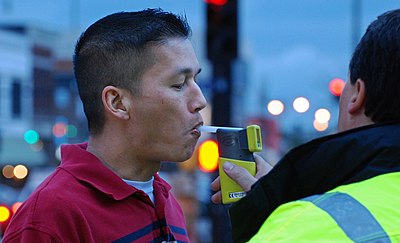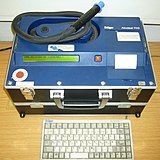Breath alcohol determination
With breathalyzer the measurement of the alcohol content is in the breathing air , respectively. After consuming alcoholic beverages or food, gas exchange takes place in the alveoli between the breath and the alcohol consumed . The alcohol contained in the peripheral blood is absorbed by the fresh air inhaled and released with the exhaled air, whereby a measurement can be made which allows conclusions to be drawn about the blood alcohol concentration .
According to the definition (§ 24a StVG ) the blood alcohol level in per mille is always twice as high as the breath alcohol content in mg / l.
application
Breath alcohol testing devices are medical products and are therefore primarily subject to European Union legislation .
development
Basic research on measuring breath alcohol concentration was carried out in 1981 at what was then the Institute for Social Medicine and Epidemiology of the Federal Health Office.
application areas
The main area of application of breath alcohol testing is traffic controls in road traffic by the police . Here, commercially available measuring devices are used directly on site for an initial check of the blood alcohol level. Since the displayed values are comparatively imprecise, if the initial suspicion is confirmed, a blood sample is subsequently ordered in order to be able to carry out an exact measurement of the blood alcohol level under controlled laboratory conditions.
So-called alcohol testers are also used in the medical field and in private use.
Carrying obligation
In France , all motorists are required to carry such a simple blowpipe (or some other device for measuring breath alcohol); The test tube must comply with the French standard, i.e. it must be marked NF (Norme française of the French standardization institute, Association française de normalization ), and it must be stable for at least one year. This regulation also applies to foreign drivers who are on holiday in France or are in transit. Vehicles with a permanently installed Alcolock are exempt from the regulation. The background to the regulation is the high number of road accidents under the influence of alcohol: Alcohol abuse while driving is responsible for 31 percent of all road deaths in France . According to the decree of February 28, 2013, failure to carry the measuring device with you will not be punished with a fee-based warning as originally intended. In fact, there is no sanctioned obligation to carry alcohol tests in any country.
Device types
Measuring devices based on different measuring principles are used. Since 1953, blow tubes have been used, which would discolour in the event of positive detection due to a chemical reaction. Today, electronic measuring devices are used that directly display a digital per mil value.
Blowpipe
The blowpipes developed by Dräger in 1953 are based on the same chemical reaction as those made up until 2016. The ethanol contained in the breath reacts with the chemicals in the tube, and the display changes in color. Each tube contains a mixture of potassium dichromate and sulfuric acid on silica gel as an inert carrier. If ethanol vapor is blown through this mixture with the exhaled air , the alcohol is oxidized to ethanal (acetaldehyde) and the orange-red potassium dichromate is reduced to green chromium (III) sulfate . The sulfuric acid serves as a proton donor, since the reaction only takes place in an acidic environment. In addition, it binds the water produced in order to prevent the acetaldehyde from reacting further to form acetic acid . The length of the discolored zone in the packing bed is an approximate measure of the breath alcohol content (AAC). A printed line can be used to indicate that a limit value has been exceeded. The reaction proceeds as follows:
Each tube can only be used once, the breathing air volume to be blown through is predefined (standardized) by the maximum volume of the inflatable bag at the exit. It must be blown in a steady puff without stopping at a moderate volume flow until the transparent PE bag is full.
These devices, known as Dräger tubes in the chemical sector, come hermetically packaged with an expiration date and are only used for analysis. The devices with digital display described below, however, are provided with a freshly unpacked mouthpiece on the breathing air inlet or hose, which is also used only once and thus creates hygienic conditions. The semi-transparent mouthpiece , conical on both sides, usually integrates a non-return valve, the platelet of which also separates droplets of saliva that are carried along by impact.
Handheld measuring devices
As a further development of the "blow tubes", hand-held measuring devices were introduced, which are now frequently used by the police. The measurement is no longer based on a chemical reaction with a color change, but the change in potential between two electrodes, which depends on the ethanol content, is measured electrochemically. The measurement error of commercially available devices is relatively small (± 5%) and the devices can be used multiple times. However, the systems must be calibrated at regular intervals.
Stationary measuring devices
With the stationary measuring devices, a double measurement takes place: both electrochemically (as with the handheld measuring devices) and physically using infrared measurement. Measured values determined with this double measurement are up to 0.54 mg / l in court since 1998 as conclusive if it is only a matter of regulatory offenses; in the case of criminal offenses, a more precise determination using a blood sample is still required. The prerequisite is correct operation of the systems, for example compliance with a minimum time between the last alcohol consumption and measurement.
Alcohol ignition lock
An alcohol ignition lock (other names include alcohol interlock , Alcolock ) is the technical connection between a device for determining breath alcohol and an immobilizer . It is permanently installed in motor vehicles and is intended to prevent driving under the influence of alcohol by means of an ignition lock.
Basics of the measurement process
The different types of automatic measuring devices are based on different measuring methods for determining the alcohol content in the breath. The three most frequently used methods are based on semiconductor sensors, infrared spectroscopy or electrochemical measuring cells.
Semiconductor sensor
If a semiconductor sensor is exposed to a gaseous substance from the ambient air, this reacts by changing the electrical conductivity of the gas-sensitive sensor layer. Semiconducting metal oxides are often used as the sensitive layer . Typical of this are tin dioxide , tungsten oxide, titanium dioxide and zinc oxide . Since these have a large band gap, they must be heated to temperatures between 200 ° C and 600 ° C during operation so that good intrinsic conductivity begins. A reversible adsorption of oxygen molecules takes place on the surface of the sensor layer. At these high temperatures, the absorbed oxygen molecules can withdraw electrons from the conduction band of the detector , creating a state of reduced conductivity. If gases such as ethanol come into contact with the surface of the sensor, oxidation takes place with the consumption of oxygen molecules . The electrons are returned to the conduction band and the conductivity is increased again. Alcohol testers with semiconductor sensors not only measure ethanol, they also react to:
- Carbon monoxide (in smokers),
- Acetone (in people with diabetes),
- Ammonia (in people with liver and metabolic diseases).
Infrared sensor
The principle of infrared spectroscopy ( IR spectroscopy ) is used in this measurement method . A light source emits light of different wavelengths in the infrared spectral range . The light passes through two windows and an interference filter . The interference filter only lets through a certain wavelength in the range of around 9.5 μm . A radiation detector measures the intensity of the incoming light and transmits the corresponding signal to the processing electronics . If there is a gas ( ethanol ) between the two windows , it will absorb this particular wavelength of light. Thus the light intensity at the detector and thus its electronic output signal decrease. The longer the light path and the more concentrated the gas (ethanol concentrate), the greater this decrease.
Electrochemical sensor
The method for determining breath alcohol using an electrochemical sensor works on the principle of the fuel cell . In such a measuring system there is a measuring electrode, a counter electrode and a small amount of electrolyte . The electrolyte and the electrode material are chosen so that the substance to be analyzed ( ethanol ) is electrochemically oxidized on the catalyst layer of the measuring electrode. On the opposite side, ambient oxygen is withdrawn from the cathode . This creates an electrode current that can be measured via a load resistor. Here, too, other substances can be falsely recognized, for example:
- Methanol ,
- Carbon monoxide (in smokers),
- Acetone (in people with diabetes),
- Isopropanol ,
- Acetaldehyde ,
- Eucalyptol (after consuming confectionery),
- Ammonia (in people with liver and metabolic diseases),
- Hydrocarbons .
Data processing
In all processes, the electrical signals are amplified and interference is filtered out as much as possible. The signals are processed by electronics and the result is displayed on a screen . In the first method (semiconductor sensor), a current is measured that changes with the change in conductivity of the sensor. If the alcohol content increases, the conductivity increases and so does the current to be measured. In the second method (infrared sensor) the incoming light intensity is measured with a detector. If the light shines through a higher concentration of alcohol, the incoming light intensity is lower and thus the signal. In the last process (electrochemical sensor), the current is measured over time. This determines the complete electrical charge that arises during the electrochemical reaction . The greater the proportion of alcohol in the air, the greater the charge.
See also
literature
- Michael P. Hlastala: The alcohol breath test - a review . In: Journal of Applied Physiology . Vol. 84, No. 2 , 1998, p. 401–408 ( mphlastala.com [PDF; 217 kB ]).
Web links
Individual evidence
- ↑ Günter Schoknecht with the collaboration of Hans-Ulrich Melchert and Wolfgang Thefeld: Testing of electronic breath alcohol test procedures - a statement from the Federal Health Office. SozEp reports 1981/8, D. Reimer Verlag, Berlin, ISBN 3-496-02114-4 .
- ↑ Obligation to carry alcohol tests in vehicles from June 1, 2012 Website of the French Embassy of March 8, 2012. Accessed on April 3, 2012.
- ↑ Décret n ° 2012-284 du 28 février 2012 relatif à la possession obligatoire d'un éthylotest par le conducteur d'un véhicule terrestre à moteur Text of the legal regulation of February 28, 2012. Accessed on April 3, 2012.
- ↑ Carrying an obligatory alcohol test in France Website of the French Embassy in Berlin from March 11, 2013. Accessed on May 2, 2013.
- ↑ The obligation to carry out alcohol tests in cars is off the table. In: Die Welt , February 18, 2013, accessed August 15, 2015.
- ↑ Dräger says goodbye to Alcotest tubes. welt.de, February 10, 2016.




